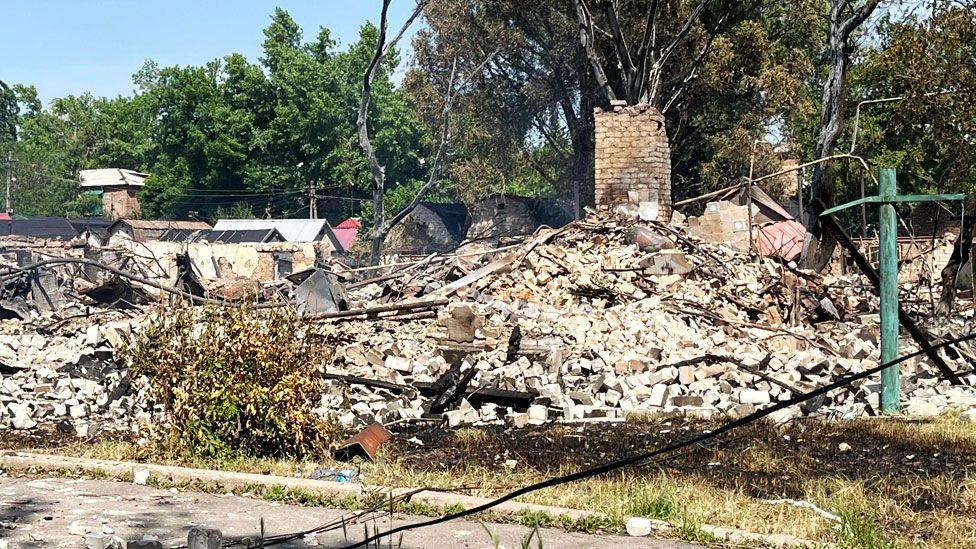Record number of drone attacks signals dangerous shift in war
Watch: The sky over Kyiv during the barrage of Russian drones
- Published
Large-scale Russian drone attacks on Ukrainian cities are on the rise.
Monday night's bombardment, while not record breaking, was typical of the new norm.
For several hours after midnight, drones buzzed incessantly over Kyiv.
It seemed they were coming from almost every direction, as searchlights raked the sky and skeins of orange tracer fire rose from air defence units stationed around the city.
As each drone approached, the streets would echo with the deep rattle of heavy machine gun fire.
From our hotel, a fire could be seen raging in the distance, as a fiery orange moon, nearly full, slowly faded as if unwilling to compete.
Loud explosions would mark a successful interception, or a drone reaching its target.
Sitting underneath all this drama, it is hard to keep a sense of perspective.
The word "massive" is routinely used in official statements.
But a glance at the statistics tells an unmistakable story: away from the front lines, Ukraine is in the midst of the most sustained bombardment since the early stages of Russia's full-scale invasion, with a sharp increase in the number of drones.
Russian strikes in Ukraine hit Kyiv and kill two in Odesa
- Published10 June
Biggest drone strike hits Ukraine's second city
- Published7 June
In the three months before August last year, Russia fired a total of 1,100, according to a report by Ukraine's general staff.
A steep rise followed, with 818 drones recorded in August, 1,410 in September and more than 2,000 in October.
But the numbers just keep going up.
In May, for the first time, the number of drones exceeded 4,000. This month is likely to set a new record.
Since the start of June, Russia has fired an average of 256 projectiles every 24 hours, according to figures compiled by the Ukrainian air force.
The overwhelming majority of these are drones, including Shahed-type models and various decoys designed to confuse Ukraine's air defence systems.
Russia first started using Iranian-supplied Shaheds - the word means "martyr" - in late 2022.
But by the following summer, it was producing its own variant, known as Geran, at a special economic zone in Yelabuga, in the Russian republic of Tatarstan.
According to Artem Dehtiarenko, spokesman for Ukraine's security service, the SBU, 25,000 drones have been produced there, with a further 20,000 assembled from previously supplied Iranian components.
Of 315 detected during Monday night's bombardment, 250 were actual strike drones, according to Ukraine's air force spokesman, Yurii Ihnat.
"Most of them were headed specifically for Kyiv," he told the Ukrainian RBC news agency.
A total of seven ballistic and cruise missiles were also fired at the capital.
It meant another sleepless night for Kyiv's long-suffering population.
"It's become more intense," Katya, a Kyiv resident told me.
"It used to be easier emotionally. Now it's somehow become harder."
And it's not just the intensity of the strikes. After hundreds of similar nights, people in Kyiv can sense the subtle shifts in technology as Russia develops its capability.
"There are more drones with a slightly different sound than before," Katya said.
The SBU's Dehtiarenko says Russia is making constant modifications.
"Russian engineers have been tasked with increasing their destructive power in order to maximise devastation and civilian casualties," he said.
"In addition, efforts are being made to make the Geran drones less vulnerable to Ukrainian air defences."
Apartment blocks and office buildings were among the locations hit on Monday. Kyiv generally avoids saying if damage was caused to anything that might be considered a military target.
But a statement from the culture ministry said that for the first time, Kyiv's St Sophia cathedral felt the impact.
St Sophia's is a Unesco World Heritage Site and one of Ukraine's most significant cultural and religious monuments, with spectacular 11th Century mosaics and frescoes.
A blast wave is said to have damaged a plastered cornice on the eastern façade but not affected the interior.
"However, any vibrational impact caused by explosions poses a serious threat to the integrity of the structure," the ministry said in a statement.
- Published28 May


